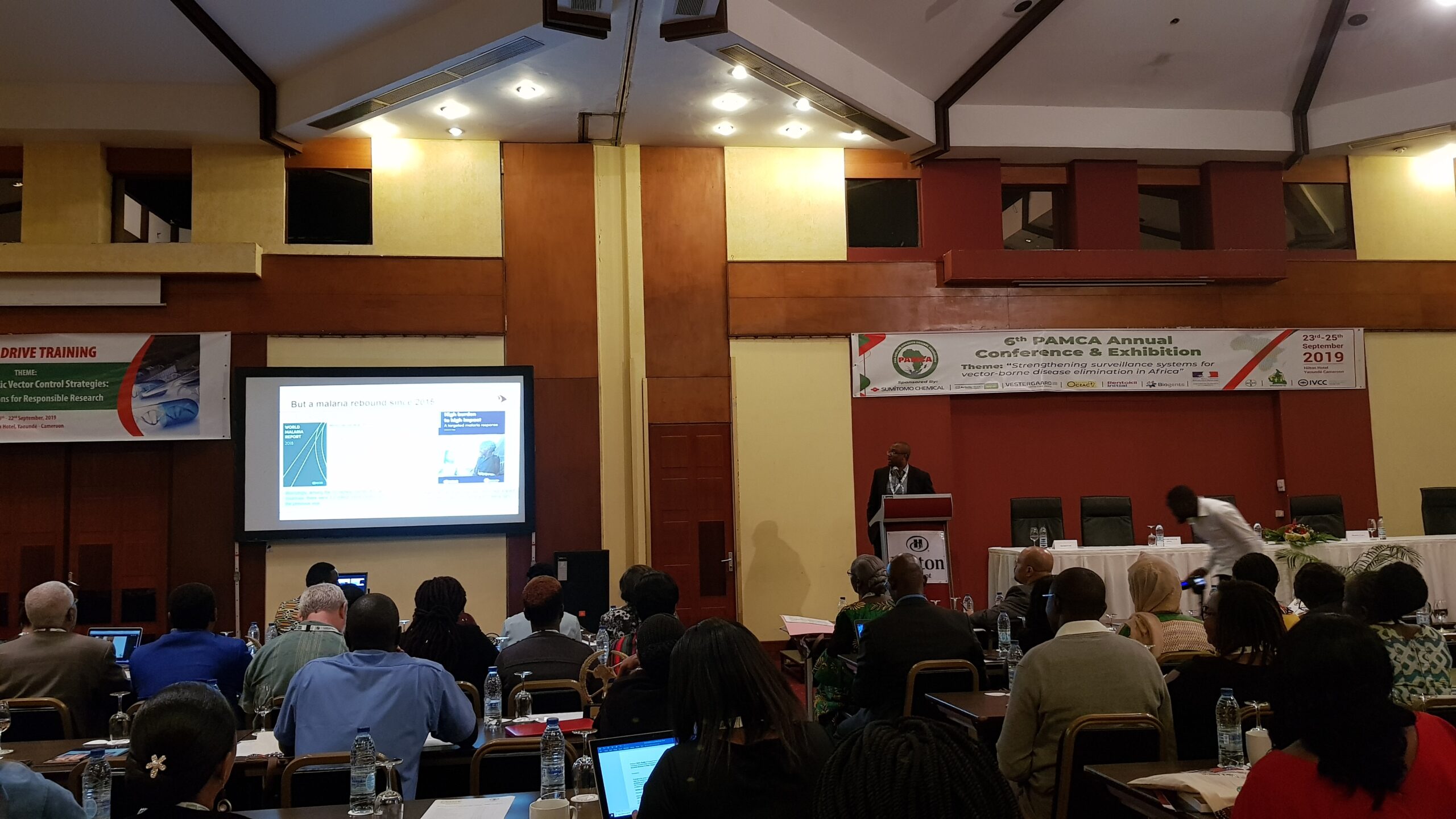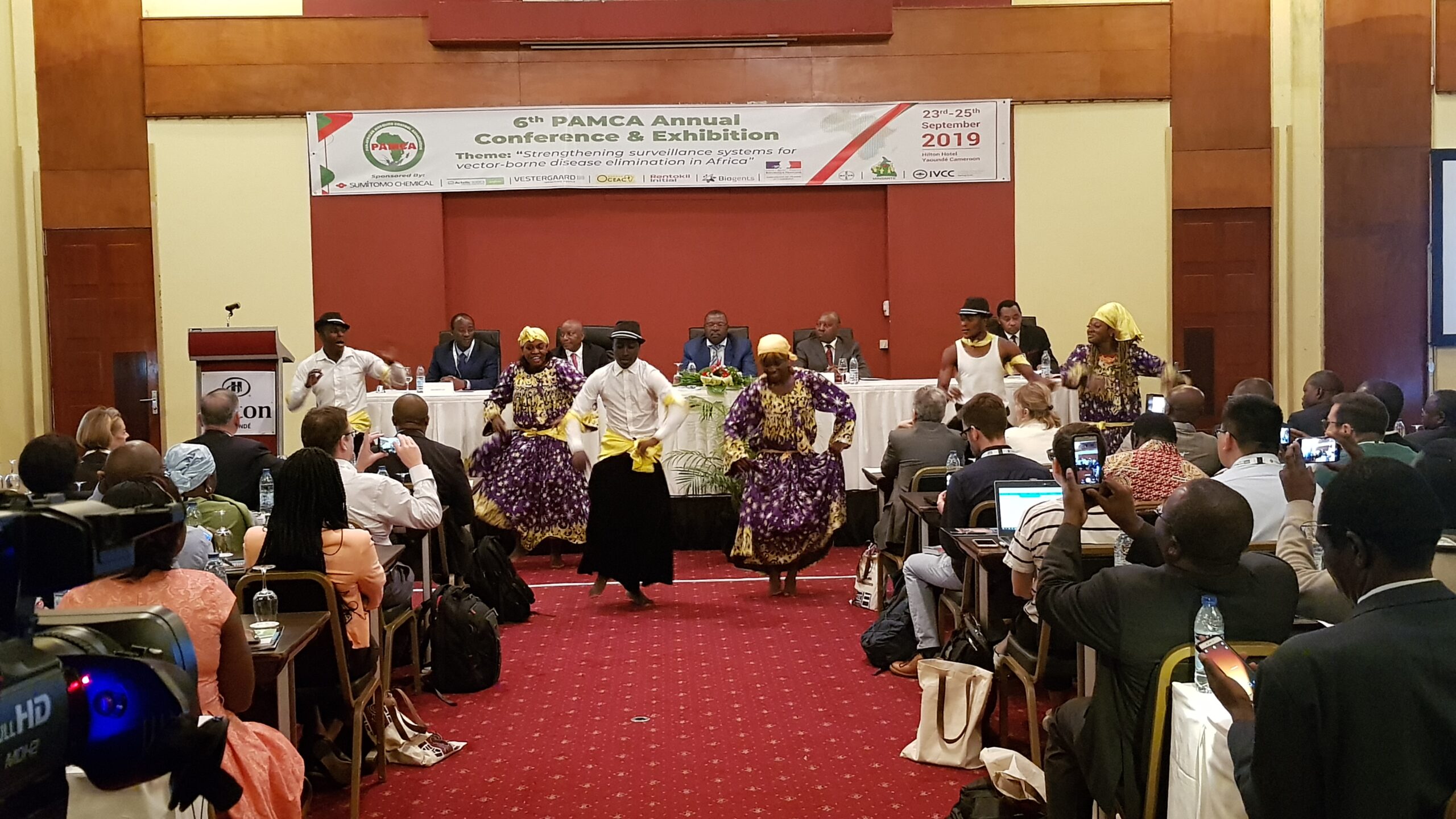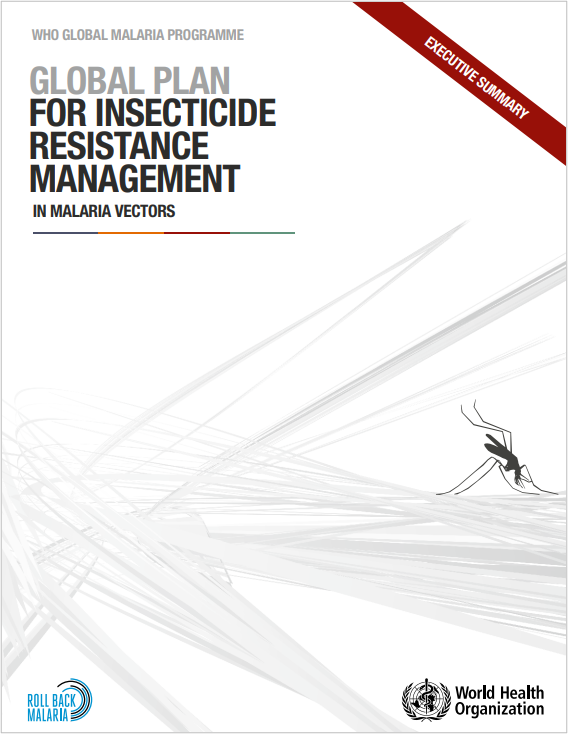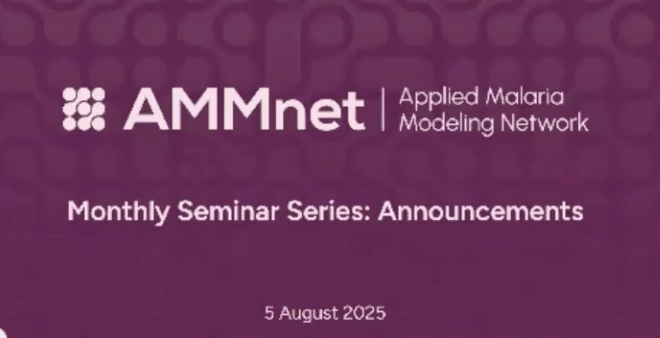6th PAMCA Annual Conference and Exhibition – 2019: Day 1
Monday, 23rd September 2019
Published: 20/09/2019
This report is brought to you by the MESA Correspondents Nathalie Amvongo Adjia, Joanna Furnival-Adams, Teresia Njoroge, and Trizah Koyi. Senior editorial support has been facilitated by Elijah Juma and Silas Majambere.
THEMES: THEMES: Vector Control
MESA Correspondents bring you cutting-edge coverage from the 6th PAMCA Annual Conference & Exhibition
Day 1: Monday, 23rd September 2019
Opening Ceremony
Dr Antonio-Nkondjio Christophe (Organisation de Coordination pour la lutte contre les Endémies en Afrique Centrale, OCEAC) chair of the local organizing committee, opened the stage of this 6th Pan-African Mosquito Control Association (PAMCA) Annual Conference organized for the first time in Yaoundé, city of 7 mountains, Cameroon, Central Africa. Dr Christophe emphasized the need to break down the deadly cycles of the vector-borne diseases (VBDs) as one of the prerequisites to achieve economic prosperity in Africa. This conference provides a platform to enable the exchange of knowledge, capacities, and actions and face the challenges to foster the elimination of VBDs in Africa.
PAMCA president Prof Charles Mbogo (Kenya Medical Research Institute, KEMRI, and University of Nairobi, Kenya) expressed a very warm welcome to all conference participants and took the opportunity to recapture the PAMCA vision of an “Africa free of vector-borne diseases.” With about 350 participating delegates, this 3-day event follows two pre-conference workshops: the Gene Drive Technology Training Course and the Women in Vector Control Workshop. These workshops served to equip young African scientists, especially women, with effective tools to enable them to play their rightful role in the control of VBDs in Africa. Prof Mbogo concluded that “one of the key drivers of PAMCA is to comprehensively develop vector surveillance in one voice, in one action to combat vector-borne diseases – we do not want to continue working in isolation, but in unison.”
James Newell spoke on behalf of Dr Prosper Chaki, PAMCA Executive Director, and reminded the audience of the necessity to build entomological capacities, robust systems and to use appropriate management systems that can enable the African continent to respond effectively to VBDs.
Dr Phanuel Habimana (WHO Cameroon Representative) emphasized the tremendous burden imposed by VBDs in Africa with malaria-causing the highest burden.
Finally, Dr Manuel-Nso Obiang (OCEAC Executive Director) presented OCEAC’s facilities and its technical platform. These assist central African countries in their fight against infectious and vector-borne diseases through health policy development, research and training, and health emergency management and responses.
After being treated to a taste of the Cameroonian cultural dance by the University of Yaoundé musical group, Prof Joseph Lebel Tamesse, the representative of the Minister of State Higher Education, presided over an award ceremony to recognize 15 outstanding scientist/researchers. This was followed by a group photo, a stunning musical performance, and an official opening address by Prof Tamesse.
Keynote address
Prof Charles S. Wondji (Liverpool School of Tropical Medicine, UK and Centre for Research in Infectious Diseases, Cameroon, ED CRID and Wellcome Trust Senior Research Fellow in Biomedical Sciences) highlighted the current challenge of genomic evolution of insecticide resistance facing pyrethroid-based interventions of malaria vectors. He cited over-reliance on a single class of insecticides, the pyrethroids, as a major cause of resistance that necessitates the diversification of control tools and strategies. He further emphasized the need for molecular markers for the detection of insecticide resistance in the major malaria vectors in Africa (An. gambiae and An. funestus). Additionally, the operation of resistance management strategies early enough will help to manage the spread of insecticide resistance. New approaches are also needed beyond IRS and LLNs to reduce malaria transmission, for instance, genetic approaches such as CRISPR-cas9 and gene drives; and capacity development through training of the next generation of African researchers on mosquito-borne diseases control.
The opening session was also graced by the presence of Rodger Milla, the PAMCA goodwill ambassador. Mr. Milla is a former Cameroonian footballer, and his passion for malaria stems from his personal experience as a victim of the malaria scourge.
Prof Hilary Ranson (Liverpool School of Tropical Medicine, UK) provided an overview of the current status of malaria burden in Burkina Faso. This country still bears a high malaria burden despite high coverage and use of bed nets. A longitudinal study in Burkina Faso revealed presence of pyrethroid resistance and poor health-seeking behaviour of adults. The highlight of the talk was the need for a multidisciplinary approach in malaria control.
Agapitus Kato (Ministry of Health Uganda, Uganda Virus Research Institute) demonstrated how the design of cost-effective and scalable implementation systems for larviciding policies could reduce malaria transmission in Uganda, especially in large populations. Jessy Marlene Goupeyou-Youmsi (University of Malawi and Institut Pasteur) talked about the susceptibility of Anopheles mosquitoes to Plasmodium falciparum and Plasmodium vivax infections in Madagascar. Her work demonstrated the need to monitor P. vivax infections in clinics and mentioned the potential for vector control to prevent both P. falciparum and P. vivax infections. Elodie Vajda (University of California San Francisco) discussed a novel Entomological Surveillance Planning Tool (ESPT) to improve vector-control decision-making. This tool provides national malaria programs with a decision framework for entomological surveillance planning, analysis of entomological data, and for measuring human behaviour associated with vector behaviour. Mutale Chisanga (Macha Research Trust, Zambia) showed how a reference laboratory that offers entomological services to other research institutes enabled Zambia to successfully support programmatic operations in the area of entomological surveillance. Aurelie Prisca Yougang (University of Yaoundé 1, Cameroon) presented a study about the susceptibility profile and mechanisms involved in insecticide resistance in populations of Aedes albopictus in Cameroon. Efundem Agboraw (Liverpool School of Tropical Medicine, UK) discussed a systematic review of the cost and cost-effectiveness of malaria control strategies and related health outcomes.

Parallel session 2: Mosquito genomics: progress and challenges
Nsa Dada (CDC, USA, KEMRI, Kenya) talked about microbiota-mediated insecticide resistance. Dada’s study demonstrated significant differences in the bacterial composition and putative enzymes of resistant vs. susceptible mosquitoes. Flore M. M. Kouamo described a study outlining the role of GST genes in conferring resistance to pyrethroids/DDT, followed by Tony Nolan (Liverpool School of Tropical Medical, UK), who described a study detailing an improvement to the CRISPR-Cas 9 gene drive system, a mosquito genetic control that is being explored for mosquito population suppression and population replacement strategies.
Thabo Mashatola (National Institute for Communicable Diseases of the National Health Laboratory Service, South Africa) talked about a review of the progress of sex-separation techniques for sterile insect technique (STI) application against Anopheles arabiensis. Alistair Miles’ (The An. gambiae 1000 genome consortium) presentation focused on the An. gambiae genome, specifically looking at single nucleotide polymorphisms (SNPs) and copy number variations (CNVs). Interestingly, Cytochrome P450 gene cluster is a CNV hot spot. Also, he explained how these genes can be exploited for surveillance/insecticide resistance management.
David Weetman (LSTM, UK) then talked about gene duplication and selection and how these processes can drive the spread of organophosphate resistance in African An. gambiae. Keith R. Hayes (The Commonwealth Scientific and Industrial Research Organisation, CSIRO, Australia) provided insights on risk assessment (e.g. effect on target organism, spread, and persistence, horizontal gene transfer) with respect to genetic control methods for malaria vectors.
Symposium 1: Guidance on stakeholder engagement principles to inform the development of area-wide vector control methods
New vector control approaches have led to a renewed focus on stakeholder engagement and consent. Area-wide interventions require a community-based approach. Delphine Thizy (Imperial College London, UK) discussed the importance of responsible and thorough stakeholder engagement during the R&D process. Lina Finda (Ifakara Health Institute, Tanzania) and Damaris Matoke-Muhia (Research Scientist, KEMRI, Postdoctoral Fellow, ICIPE, Kenya) discussed the need for alternative and supplementary strategies. Lea Pare Toé (Institut de Recherches en Sciences de la Santé, IRSS-Burkina Faso) explained the seven years community engagement with a release project of sterile male mosquitoes in Burkina Faso through step-by-step engagement, inclusive engagement, and transparency in the research.
Parallel session 3: Vector biology and control
Caroline W. Kiuru (Max plank Institute for Infection Biology, Germany) talked about the role of bacteria in mosquito growth and development. Using different E. coli mutants, she highlighted two different pathways that influence mosquito larvae development. Etienne Fondjo (Abt Associates, Cameroon) described how he used different approaches to assess insecticide resistance intensity in An. Gambiae. His work focused on four sentinel sites in Cameroon and selection of these sites were based on malaria transmission levels. Delenasaw Yewhalaw (Jimma University, Ethiopia) focused on pyrethroid resistance in malaria vector populations in Ethiopia. From his findings, he suggests that Pyrethroid-PBO nets should be incorporated in areas with pyrethroid-resistant mosquito populations. Kenyssony Valera (Abt Associates, Mozambique) presented a study conducted in Mopeia, Mozambique evaluating the impact of a third-generation IRS. The use of this product resulted in a reduction of An. funestus, both outdoor and indoor. Theresia Nkya (ICIPE, Kenya) presented the experimental design of a project that assessed the feasibility and impact of community-based winter larviciding on malaria transmission in Namibia, Botswana, and Swaziland.
This report is brought to you by the MESA Correspondents Nathalie Amvongo Adija (Institute of Medical Research and Medicinal Plants Studies, Cameroon), Joanna Furnival-Adams (Liverpool School of Tropical Medicine, UK), Trizah Koyi (International Centre of Insect Physiology and Ecology, Kenya) and Teresia Njoroge (University of Illinois at Urbana-Champaign, USA) with mentoring and editorial support from MESA and MalariaWorld. Senior editorial support has been facilitated by Elijah Juma & Silas Majambere from PAMCA. This report is cross-posted on the MESA Website and on MalariaWorld.
Published: 20/09/2019
This report is brought to you by the MESA Correspondents Nathalie Amvongo Adjia, Joanna Furnival-Adams, Teresia Njoroge, and Trizah Koyi. Senior editorial support has been facilitated by Elijah Juma and Silas Majambere.
THEMES: Vector Control


